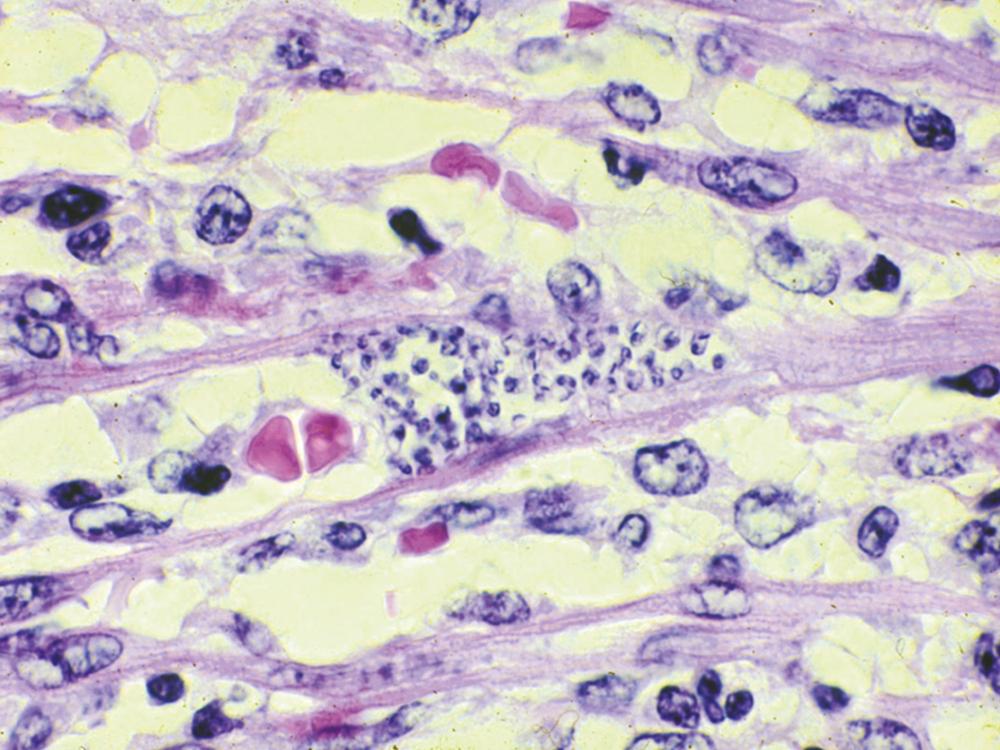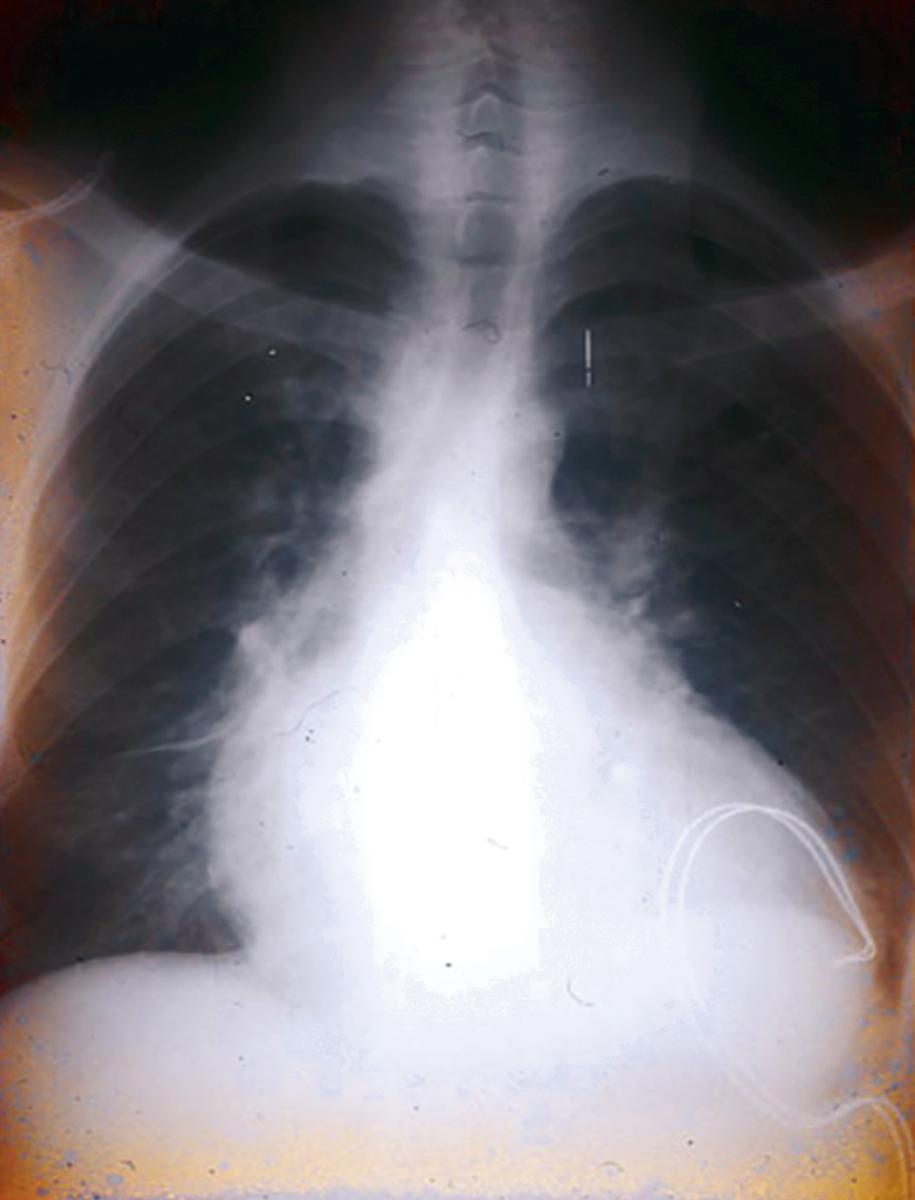Physical Address
304 North Cardinal St.
Dorchester Center, MA 02124
Chagas disease, or American trypanosomiasis, is caused by the protozoan parasite Trypanosoma cruzi . The terms Chagas disease , American trypanosomiasis , and T. cruzi infection are synonyms.
Several dozen species are included in the genus Trypanosoma , but only the African trypanosome Trypanosoma brucei (subspecies T. b. gambiense [West African] and T. b. rhodesiense [East African]) ( Chapter 317 ) and the American trypanosome T. cruzi cause disease in humans.
Many species of triatomine insects, also called kissing bugs, act as vectors for T. cruzi, and many species of wild and domestic mammals, as well as humans, are involved in the complex lifecycle of this organism. The triatomine vectors that transmit T. cruzi are found in the Americas from southern Argentina through the southern half of the United States. The parasite has been isolated from more than 100 species of domestic and wild mammals, which for the most part become infected when they eat infected vectors or through congenital transmission. Armadillos, wood rats, raccoons, and opossums are typical wild mammalian reservoirs, and these and other species that harbor T. cruzi can be found in large numbers in the southern and southwestern parts of the United States.
Typically, humans acquire T. cruzi infection, which is lifelong, when they live in houses in enzootic areas where the sylvatic cycle of transmission is active. The process begins when vector species adaptable to living in human dwellings take up residence in niches in the primitive wood, mud, and stone houses that are typical in many endemic regions. These vectors become domiciliary, and they then take blood meals, mostly at night, from the humans who occupy the dwellings that they have invaded, as well as from domestic animals that sleep there, particularly dogs. Thus, Chagas disease is primarily a public health problem among poor people who live in rural areas.
Chagas disease is a zoonosis that is endemic in Mexico and in all the countries of Central and South America, but it is not endemic in the Caribbean islands. In 2018, the Pan American Health Organization estimated that in the 21 endemic countries, 6 to 8 million people are chronically infected with T. cruzi , 28,000 new cases occur each year, and up to 12,000 deaths result from Chagas disease annually. Since 1991, a major international vector control program in the southern countries of South America (Chile, Argentina, Paraguay, Brazil, Bolivia, and Uruguay) has achieved a marked reduction in vector transmission of T. cruzi through housing improvement, education of people at risk for acquiring the infection, and spraying insecticides. Substantial reductions in prevalence rates in school-aged children and in blood donors constitute clear evidence of the success of the program. Uruguay, Chile, and Brazil were certified as being free of vector transmission in 1997, 1999, and 2006, respectively. Marked reduction in transmission has been achieved in Argentina as well. Similar programs have been initiated in Central America and the Andean countries. In parallel with the vector control programs, donor screening has been implemented throughout almost the entire endemic range.
The sylvatic cycle of T. cruzi exists in much of the southern and southwestern regions of the United States, but only seven cases of autochthonous (disease spread from one individual and acquired in another individual in the same place) acute Chagas disease have been reported: four in Texas and one each in Tennessee, Louisiana, and California. Moreover, in the first 4 years of U.S. blood donor screening starting in January of 2007, only 16 T. cruzi –infected donors, all of whom appeared to have acquired the infection autochthonously, were identified in approximately 29 million units. Only two cases of acute T. cruzi infection have been reported in tourists returning to the United States, but three such instances have been reported in Europe as well as one in Canada. Thus, acute Chagas disease is extremely rare in the United States, and there is no indication that its incidence is increasing.
A recent estimate puts the number of T. cruzi –infected persons currently living in the United States at about 240,000 to 350,000, including about 40,000 women of childbearing age. Since blood donor screening began in the United States in 2007, more than 100 million units have been screened, and several thousand T. cruzi –infected donors have been identified and permanently deferred from donation. The confirmed rate of T. cruzi infection in donors is about 1 in 13,300. With the goal of reducing the enormous cost of universal screening ($100 to $200 million per year), a U.S. Food and Drug Administration (FDA)-approved selective screening protocol based on previous negative test results has been implemented.
In Europe, infection is seen primarily in Latin American immigrants to Spain, Italy, France, the United Kingdom, and Switzerland. The pooled seroprevalence among such immigrants is about 4%, with an 18% seroprevalence among immigrants from Bolivia. In the United States, transplantation of organs from three persons with undiagnosed chronic T. cruzi infection resulted in acute Chagas disease in five recipients, one of whom died of the infection. To date, two instances of congenital transmission of T. cruzi here have been reported. A reasonable estimate of the number of babies born in the United States each year with congenital Chagas disease ranges from 63 to 315. Most babies with congenital Chagas disease are asymptomatic, and limited knowledge about congenital Chagas disease leads to underreporting.
T. cruzi vectors become infected by ingesting blood from mammals that have parasites in their blood stream. The parasites then multiply in the gut of the insects and are ultimately discharged in the feces of the vector. Transmission to a new mammalian host occurs when parasite-laden vector feces contact the mucosae of the mouth or nose, the conjunctivae, or breaks in the skin. The contaminating parasites enter local cells and multiply intracellularly; as parasitized cells rupture, they are released into the lymphatics and blood stream. The circulating organisms enter new cells at distant sites and maintain an endless process of asynchronous multiplication. The life cycle is completed as parasites are swept up in blood meals taken by vectors. In addition to vector-borne transmission, T. cruzi can be transmitted by blood or organs donated by infected persons, from mother to unborn child, by the ingestion of contaminated food or drink, , and in laboratory accidents.
In acute Chagas disease, an inflammatory lesion, called a chagoma, may appear at the site where the parasite enters. Local histologic changes include intracellular parasitism of muscle and other subcutaneous tissues, lymphocytic infiltration, interstitial edema, and hyperplasia of lymph nodes that drain the area. As the parasites spread systemically through the lymphatics and blood stream, the most heavily parasitized tissues are muscles, including the myocardium, but the organisms can invade essentially any tissue. Myocarditis may develop in association with focal areas of infected cardiomyocytes, inflammation, and necrosis. The characteristic pseudocysts seen in sections of T. cruzi –infected tissues are actually host cells filled with multiplying forms of the parasite ( Fig. 318-1 ). In some patients, parasites can be seen in cerebrospinal fluid (CSF).

In persons with chronic Chagas disease, the heart is the organ most commonly affected. Hearts obtained at autopsy from patients who died of Chagas cardiomyopathy usually have a global appearance reflecting biventricular enlargement and thinning of ventricular walls ( E-Fig. 318-1 ). Mural thrombi are frequently present, and an apical aneurysm of the left ventricle is typical in patients with advanced disease. At the cellular level, the process that underlies these gross pathologic abnormalities is a chronic inflammation with mononuclear cell infiltration, diffuse interstitial fibrosis, and atrophy of myocardial cells. The chronic inflammation also affects the conduction system and causes a variety of rhythm disturbances, including atrial bradyarrhythmias and fibrillation; premature ventricular contractions; left anterior fascicular block; bundle branch blocks, often of the right bundle; ventricular tachycardia; and third-degree atrioventricular block. Parasites are rarely seen in diseased tissues by conventional histologic methods, but several studies using polymerase chain reaction (PCR) assays found a correlation between the intensity of inflammation and the presence of parasites. Evidence accumulated to date implicates the persistence of parasites and the resulting chronic inflammation in affected tissues—rather than autoimmune mechanisms—as the basis for the pathogenesis in patients with chronic T. cruzi infection.

Chagas disease of the digestive tract can cause striking dilation and hypertrophy of the esophagus or colon. Focal inflammatory lesions with lymphocytic infiltration are seen on microscopic examination of affected tissues. The number of neurons in the myenteric plexus is reduced, and periganglion and intraganglion fibrosis with Schwann cell proliferation and lymphocytosis is present. In most patients, the clinical consequences of this parasympathetic denervation are limited to the esophagus or colon (or to both), but the ureters, biliary tree, and other hollow viscera can be affected as well.
Become a Clinical Tree membership for Full access and enjoy Unlimited articles
If you are a member. Log in here